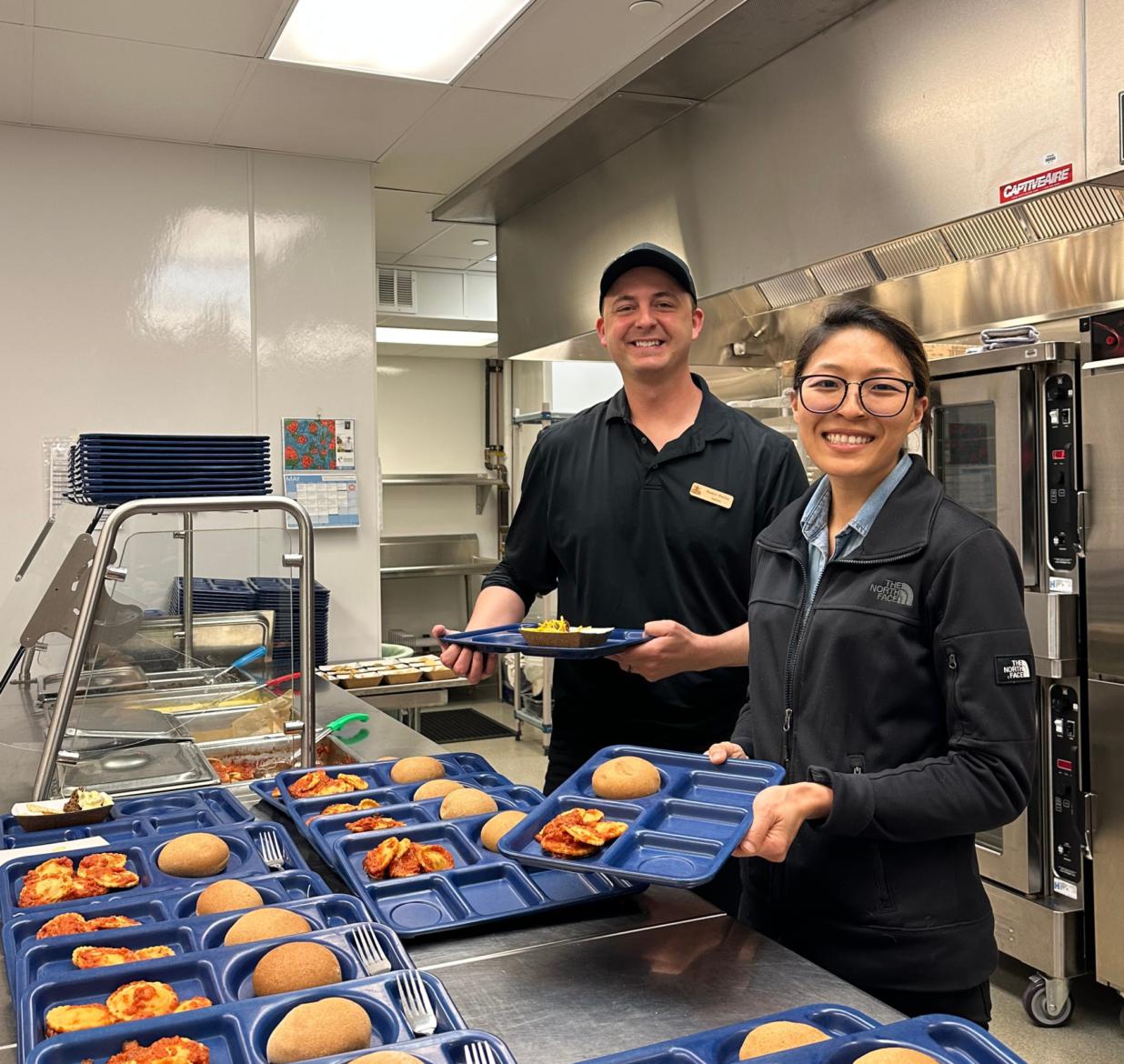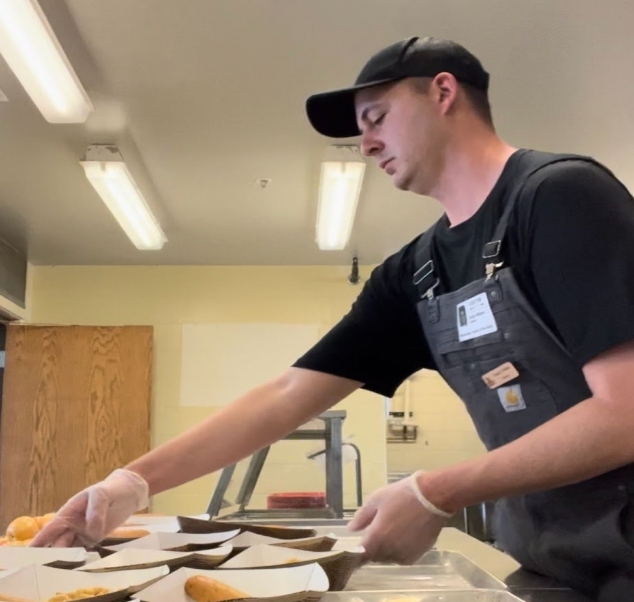
Healthy School Food Pathway's Newest Ops Specialists
May 22, 2023 | By Dani Chandler
Meet our new Senior California School Food Operations Specialists: Dustin Walker and Stephanie Lip!
The Chef Ann Foundation (CAF) is excited to welcome two new operators to the team to support our Healthy School Food Pathway (HSFP) program in California: Dustin Walker and Stephanie Lip. Dustin and Stephanie will provide technical assistance to HSFP host districts, which in turn provide work-based learning opportunities for Pre-Apprentices interested in school nutrition as a career.
Read on to learn about the expertise Dustin and Stephanie bring to the CAF team, and gain insight into their vision for the future of the HSFP program as well as the future of school food in a Q&A!
Stephanie Lip
Stephanie has previously worked in several school districts fulfilling various roles, including Culinary Specialist and Supervisor with Monterey Peninsula Unified School District; Chef with Brigaid and New London Public Schools; and most recently School Nutrition Director with Pacific Grove Unified School District.
As Senior School Food Operations Specialist, Stephanie looks forward to working with districts to build capacity in scratch cooking and to expand the workforce in school food. She also hopes to be an example for other culinary professionals to find their place in school food.


Stephanie Lip
Stephanie has previously worked in several school districts fulfilling various roles, including Culinary Specialist and Supervisor with Monterey Peninsula Unified School District; Chef with Brigaid and New London Public Schools; and most recently School Nutrition Director with Pacific Grove Unified School District.
As Senior School Food Operations Specialist, Stephanie looks forward to working with districts to build capacity in scratch cooking and to expand the workforce in school food. She also hopes to be an example for other culinary professionals to find their place in school food.

Dustin Walker
Dustin joins us from Queen Creek Unified School District where he worked as the Director of Child Nutrition. One of his admirable contributions to promoting healthy school meals was his food truck project. The project included a combination of speed-scratch and scratch-cooked items for the students weekly. Dustin also served as Spokesperson for the Arizona School Nutrition Programs Advisory Council and participated in the Creating Your Kitchen initiative through the Chef Ann Foundation and Arizona Department of Education.
Dustin is excited to connect California school districts with nutrition and culinary-focused college students to help grow a skilled workforce that is motivated to increase scratch cooking among child nutrition programs statewide.

Dustin Walker
Dustin joins us from Queen Creek Unified School District where he worked as the Director of Child Nutrition. One of his admirable contributions to promoting healthy school meals was his food truck project. The project included a combination of speed-scratch and scratch-cooked items for the students weekly. Dustin also served as Spokesperson for the Arizona School Nutrition Programs Advisory Council and participated in the Creating Your Kitchen initiative through the Chef Ann Foundation and Arizona Department of Education.
Dustin is excited to connect California school districts with nutrition and culinary-focused college students to help grow a skilled workforce that is motivated to increase scratch cooking among child nutrition programs statewide.
Reflecting on the Evolution of School Food
Q1: How has your previous experience as a Food Service Director shaped the way you think about approaching school food reform?
Dustin: The school food world is full of good people who genuinely want to serve the best food they can to their students. In my first few years as a director, my focus was primarily on ensuring that students received a nutritious meal that satisfied the federal National School Lunch Program (NSLP) guidelines. Through this experience, I learned more about the impact of food on children’s health and well-being through the work of advocacy groups and food insecurity within my community. Because of this education, my perspective started to shift. Providing students with high-quality, whole foods is important for both their cognitive and physical development. It can also be a positive thing for waste reduction with local farmers. It starts with one small change.
Stephanie: My experience as a Food Service Director gave me the hands-on opportunity to understand the various pieces to operating federal meal programs. Unfortunately, it isn’t as simple as just serving food to students. It taught me to approach making changes strategically with a collective effort. It also humbled me and reminded me to celebrate the incremental changes, no matter how big or small, because they each add value in achieving the bigger picture.
Q2: It’s an exciting time for school food in California with Healthy School Meals for All and additional funding available for districts statewide. How do you see this as an opportunity for change?
Dustin: A significant barrier for many programs is infrastructure and modifying their spaces, some many years old and lacking adequate equipment. This can pose a challenge for those wishing to expand their existing meal model. The Kitchen Infrastructure and Training Funds are an extraordinary gift from the State of California. I believe that the opportunity for school nutrition departments to really analyze their needs such as equipment, staff training needs, serving lines, and kitchen upgrades in addition to new participation through the universal meals program can catapult those that are motivated for real change in the direction they need to accomplish those goals. The scratch cooking initiative and preparing meals on-site for students is something that California has embraced and is demonstrating through the availability of these new funds. It’s an exciting time to be in school nutrition in California!
Stephanie: It is a very exciting and momentous time for districts in California to finally have some funding to assist with the growth and improvement of their operations as they work to serve more students to the best of their ability. I know there are schools out there that may have never operated school meal programs before, so this funding can help them establish one. There are also numerous school kitchens that have not been updated in years due to lack of funding or restrictions to infrastructure upgrades, so the flexibility in utilizing this funding is a huge opportunity for districts to make improvements to their kitchens while also supporting and building capacity within their staff.
Q3: What about the CA HSFP program most excites you?
Dustin: It is commonly expressed among school nutrition leaders that one of their biggest challenges is skilled labor and dealing with staffing shortages. I am excited to bring on host districts for the Healthy School Food Pathway program because it is designed to bridge the gap and provide a learning platform for culinary and nutrition-focused applicants to learn more about the operations of a school nutrition department. The topic of child nutrition was only discussed for a minute during my entire undergraduate experience, and so for there to be a program that community college students can apply for and get hands-on training within a district in their own community is powerful for both the student and the district as we work on growing the labor force.
Stephanie: From the moment I realized my own pathway into school food as a culinary professional, I haven’t looked back. It’s been the most rewarding and meaningful work I could ever imagine being a part of. That “aha” moment of realizing the potential to do something impactful with my passion and experience is what excites me most about the CA HSFP program. The program offers a great opportunity to expand the workforce within school food — to maybe help others to realize their own “aha” moments to work in school food.
Q4: How do you think your experience will help districts in California increase their level of scratch cooking?
Dustin: This is my tenth year as a professional within the school nutrition setting. School nutrition is ever-evolving, and through my experience I understand how to effectively implement change both site- and department-wide. As a former FSD, I have had many successes but also many failures that just didn’t work as well as I had hoped, but it was through those particular experiences that I learned the most, adapted, and pushed forward with the goals I had set. There is no one-size-fits-all and for my district I focused on the strengths of my crew. From there, we expanded our program to include three foodie-inspired food truck units and adopted an updated job description for our nutrition specialist position that helped prepare scratch-made items throughout the year for the school sites. I look forward to connecting with California school nutrition programs as we evolve their program into a scratch-oriented success.
Stephanie: School food is nuanced and very different from operating a standard restaurant or food establishment. I hope that my experiences as a school chef in a scratch-cooking program, as well as my district roles as Nutrition Services Supervisor and Director, help me relate to the districts we serve to help increase their levels of scratch cooking. I believe fostering relationships with the frontline staff is extremely crucial to building capacity and teaching new skills, so having been in their shoes to understand their day-to-day successes and challenges is significant.
Q5: Why do you think labor in school food is such an important issue and how will the Healthy School Food Pathway program help address it?
Dustin: The reputation of school meals has been a hard fought battle for many years as nutrition operators work hard to shape their meal program into a trendy, health and environmentally conscious, and student-focused meal program. Finding the right amount of skilled labor to take things to the next level can be difficult as wage conversations take place for food service workers, positions get updated and revamped with new funding initiatives and department needs, and revised goals. The HSFP program can help districts increase their labor force because it is designed to train the next group of school nutrition pioneers. Those Pre-Apprentices are going to be community members as they lean on local districts to support their training. Once they have completed the program, they will have motivation around school food reform and the idea is that they apply for some of those open positions within local school nutrition departments.
Stephanie: Labor in school food is a constant challenge because most positions are not fully appreciated and treated professionally. More often than not, the wages are low when compared to a local food establishment’s compensation and the work hours are too short for someone to commit to. As more districts can move toward increasing scratch cooking, this will call for more labor hours to be invested in the food service department. The HSFP program helps build capacity within existing food service staff as well as interested culinary professionals, which expands the range of people that will seek school food service opportunities. This will help districts fill their food service job vacancies and grow their scratch-cooked operations.
To learn more about Dustin, click here to read his full bio.
To learn more about Stephanie, click here to read her full bio.
The Progressive Path Ahead
It’s an extremely exciting time for school food, especially in the state of California! Get excited about the positive changes taking place and take the time to understand the volume of available grant opportunities within California to expand school nutrition programs.
This is a great opportunity for districts to receive valuable technical assistance from experienced food service operators. We look forward to connecting with interested districts who want to be a part of this movement through the Healthy School Food Pathway program.
Interested in learning more about the California Healthy School Food Pathways program? Complete this form!







